Abstract
The goal of these experiments was to investigate the relationship of ATP, phosphocreatine (PCr), inorganic phosphate (Pi), monobasic phosphate (H2PO4-), and pH to human muscle fatigue. Phosphates and pH were measured in adductor pollicis using 31P nuclear magnetic resonance at 2.0 Tesla. The force of muscle contraction was simultaneously measured with a force transducer. The effects of aerobic and anaerobic exercise were compared using two exercise protocols: 4 min sustained maximal voluntary contraction (MVC) and 40 min of repeated intermittent contractions (75% MVC). The sustained maximal contraction produced a rapid decline of MVC and PCr, and was accompanied by a rapid rise of Pi, H+, and H2PO4-. Intermittent exercise produced steady state changes of MVC, pH, and phosphates. No significant changes of ATP were found in either protocol. During fatiguing exercise, PCr and Pi had a nonlinear relationship with MVC. H+ showed a more linear correlation, while H2PO4- showed the best correlation with MVC. Furthermore, the correlations between MVC and H2PO4- were similar in sustained (r = 0.70) and intermittent (r = 0.73) exercise. The highly significant linear relationship between increases of H+ and H2PO4- and the decline of MVC strongly suggests that both H+ and H2PO4- are important determinants of human muscle fatigue.
Full text
PDF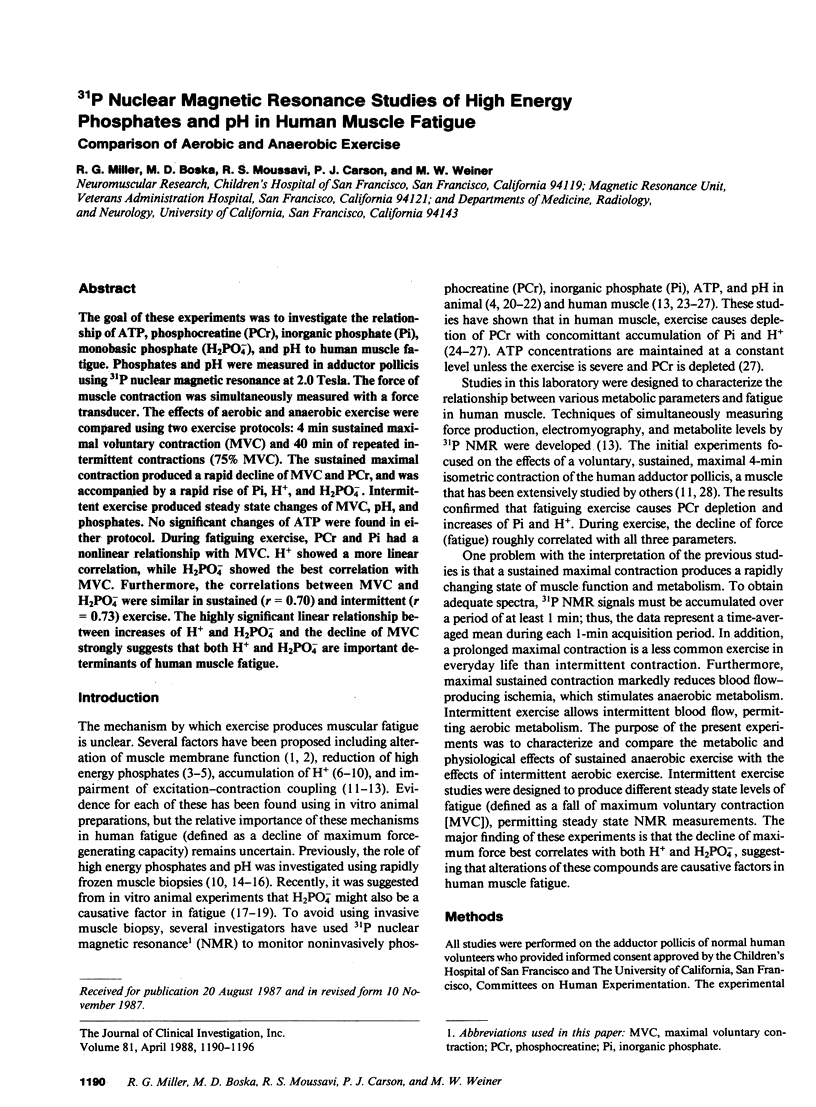
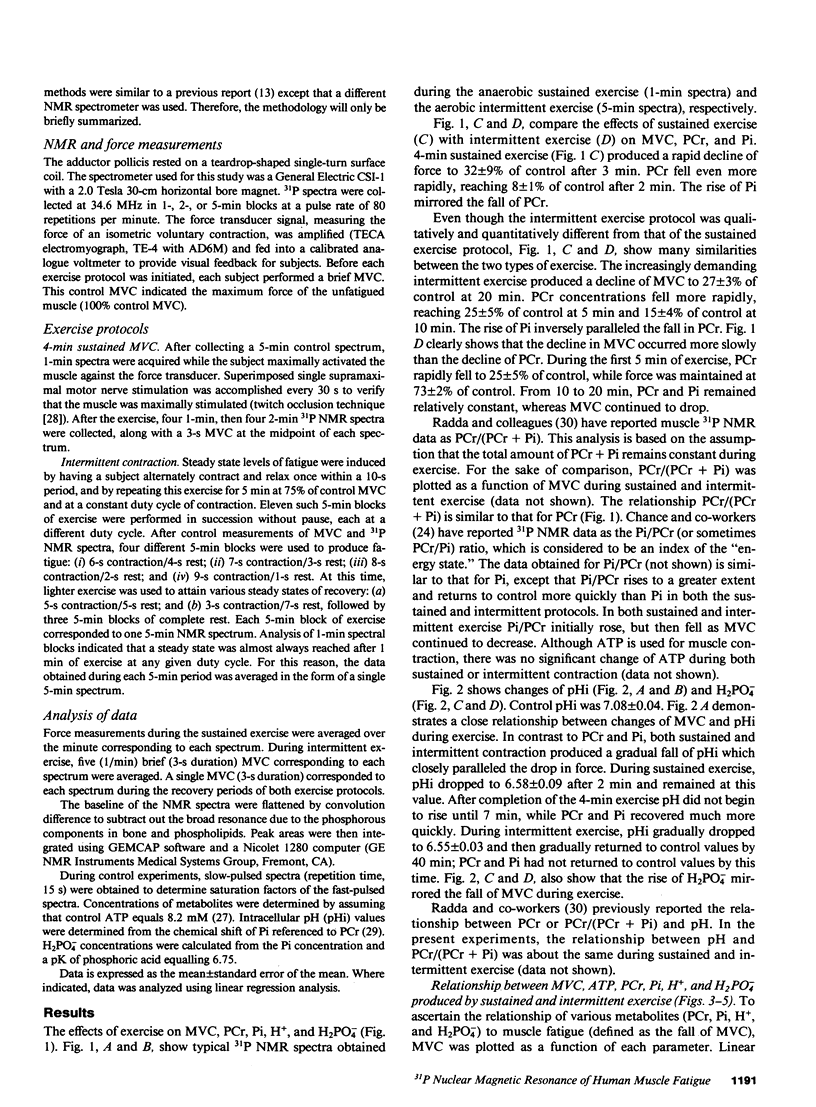
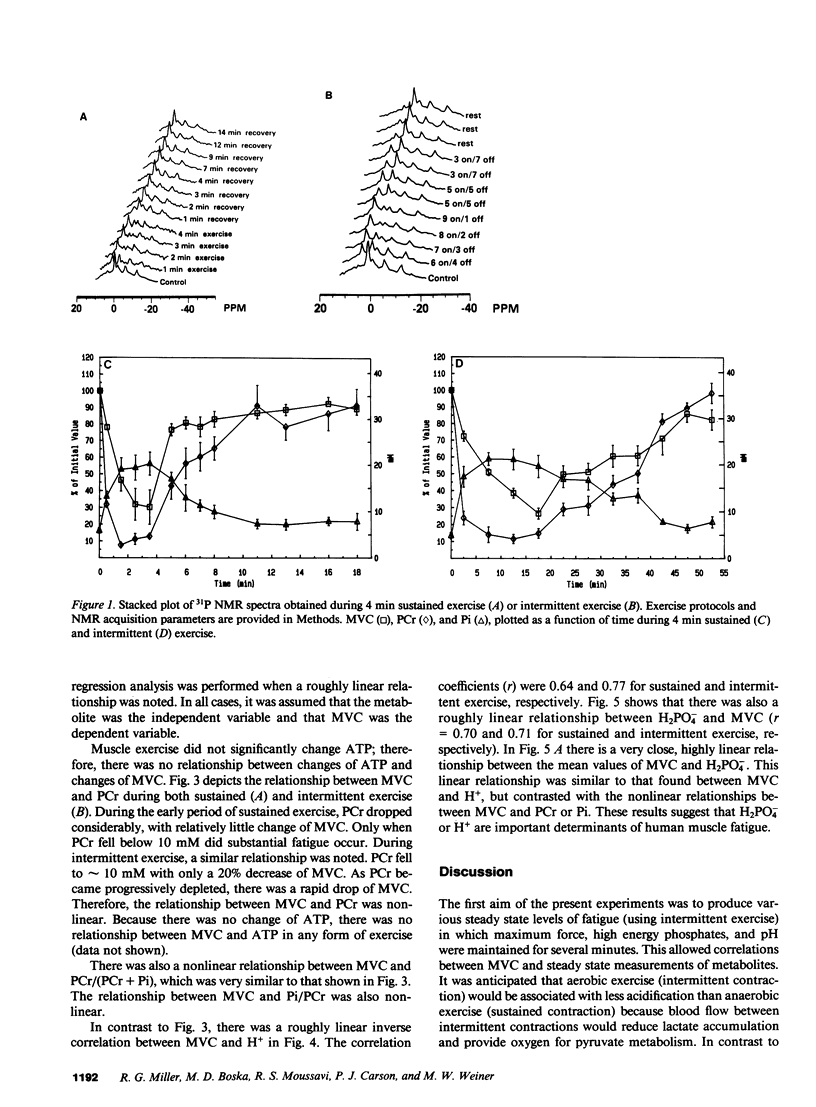
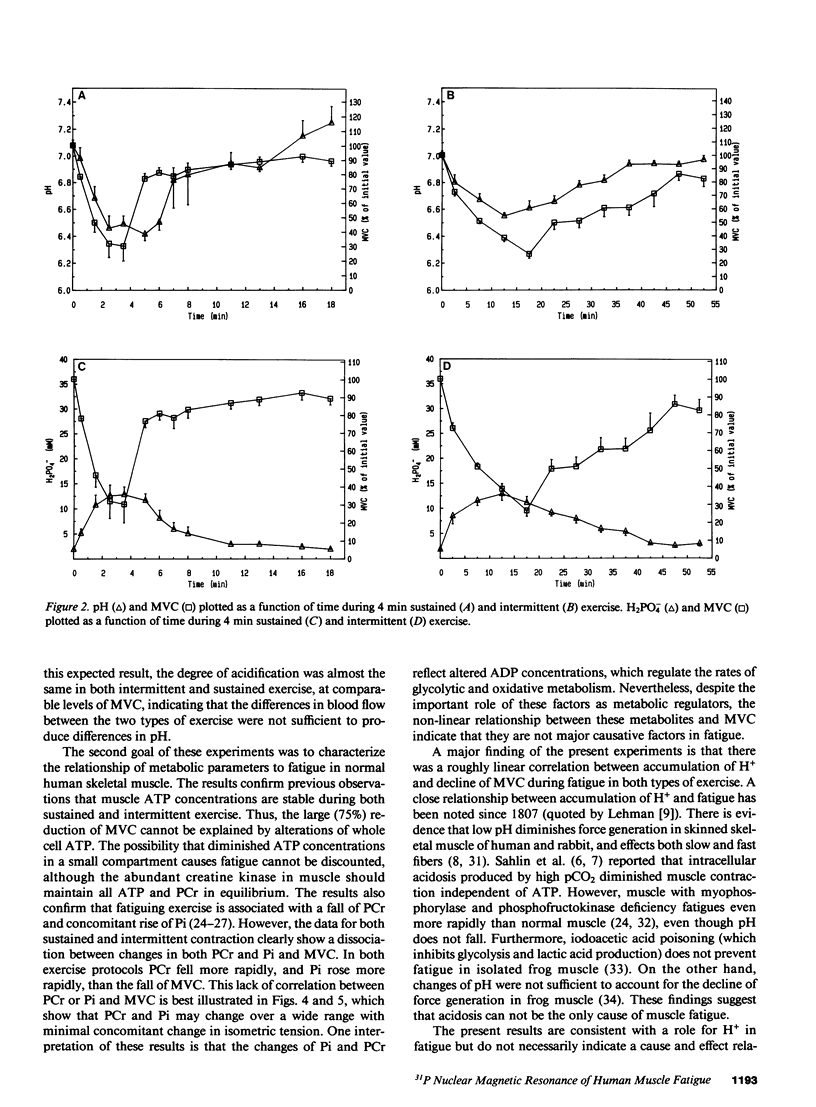
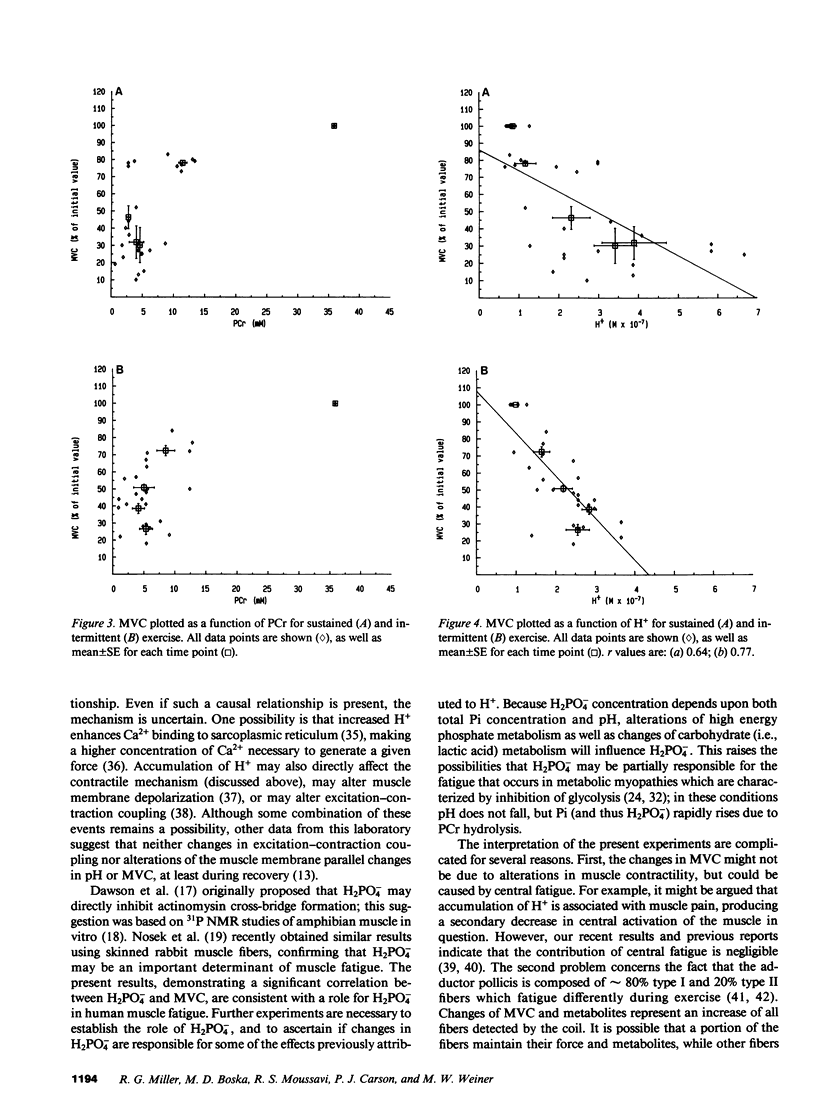
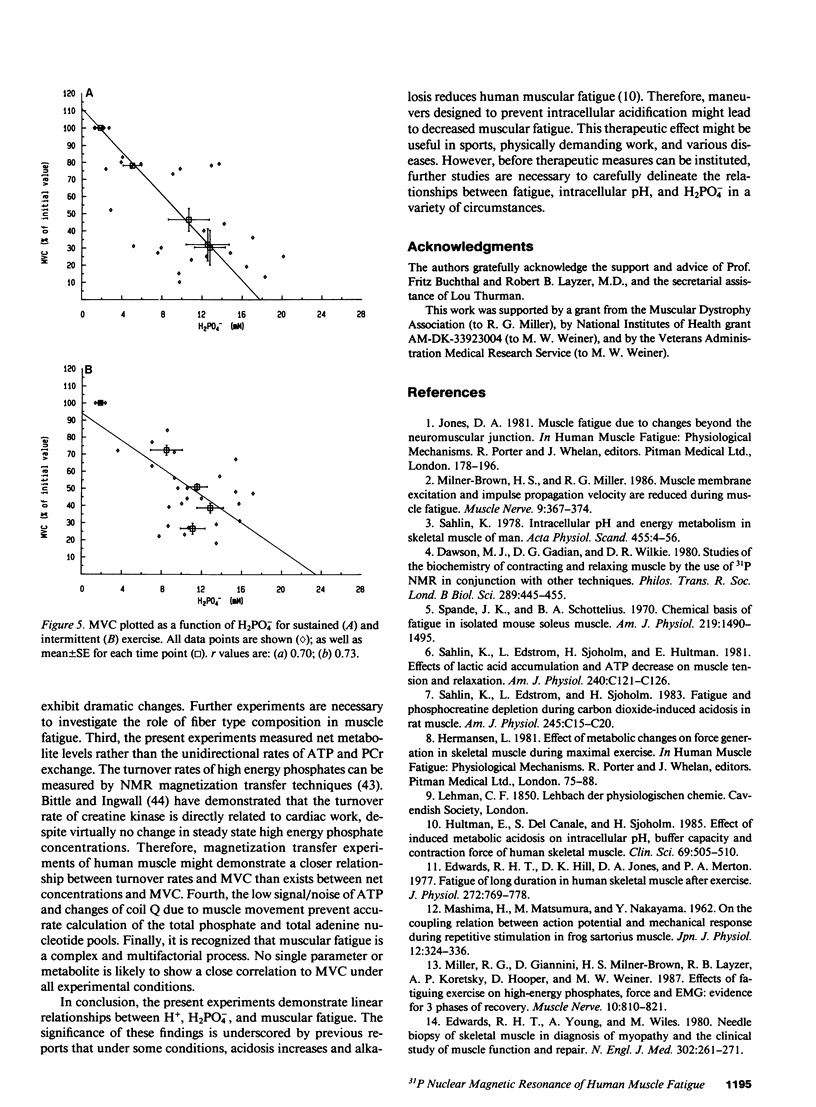
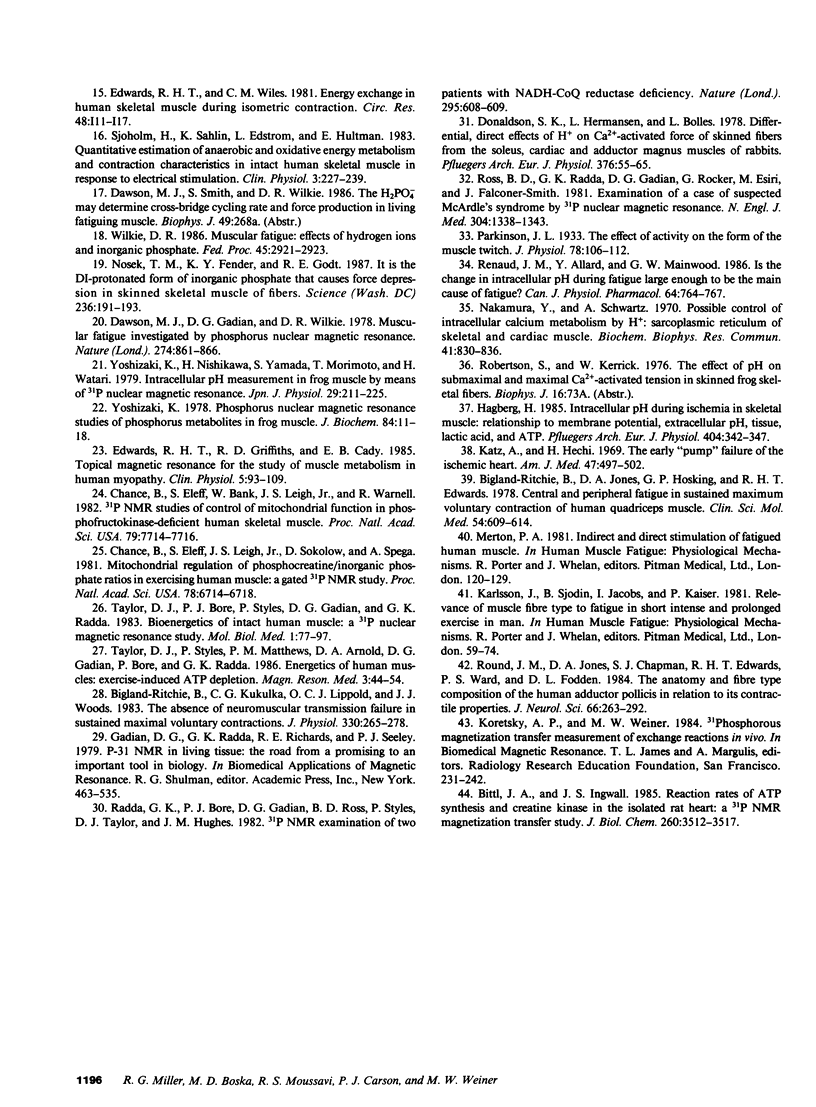
Selected References
These references are in PubMed. This may not be the complete list of references from this article.
- Bigland-Ritchie B., Jones D. A., Hosking G. P., Edwards R. H. Central and peripheral fatigue in sustained maximum voluntary contractions of human quadriceps muscle. Clin Sci Mol Med. 1978 Jun;54(6):609–614. doi: 10.1042/cs0540609. [DOI] [PubMed] [Google Scholar]
- Bigland-Ritchie B., Kukulka C. G., Lippold O. C., Woods J. J. The absence of neuromuscular transmission failure in sustained maximal voluntary contractions. J Physiol. 1982 Sep;330:265–278. doi: 10.1113/jphysiol.1982.sp014340. [DOI] [PMC free article] [PubMed] [Google Scholar]
- Bittl J. A., Ingwall J. S. Reaction rates of creatine kinase and ATP synthesis in the isolated rat heart. A 31P NMR magnetization transfer study. J Biol Chem. 1985 Mar 25;260(6):3512–3517. [PubMed] [Google Scholar]
- Chance B., Eleff S., Bank W., Leigh J. S., Jr, Warnell R. 31P NMR studies of control of mitochondrial function in phosphofructokinase-deficient human skeletal muscle. Proc Natl Acad Sci U S A. 1982 Dec;79(24):7714–7718. doi: 10.1073/pnas.79.24.7714. [DOI] [PMC free article] [PubMed] [Google Scholar]
- Chance B., Eleff S., Leigh J. S., Jr, Sokolow D., Sapega A. Mitochondrial regulation of phosphocreatine/inorganic phosphate ratios in exercising human muscle: a gated 31P NMR study. Proc Natl Acad Sci U S A. 1981 Nov;78(11):6714–6718. doi: 10.1073/pnas.78.11.6714. [DOI] [PMC free article] [PubMed] [Google Scholar]
- Dawson M. J., Gadian D. G., Wilkie D. R. Muscular fatigue investigated by phosphorus nuclear magnetic resonance. Nature. 1978 Aug 31;274(5674):861–866. doi: 10.1038/274861a0. [DOI] [PubMed] [Google Scholar]
- Dawson M. J., Gadian D. G., Wilkie D. R. Studies of the biochemistry of contracting and relaxing muscle by the use of 31P n.m.r. in conjunction with other techniques. Philos Trans R Soc Lond B Biol Sci. 1980 Jun 25;289(1037):445–455. doi: 10.1098/rstb.1980.0062. [DOI] [PubMed] [Google Scholar]
- Donaldson S. K., Hermansen L., Bolles L. Differential, direct effects of H+ on Ca2+ -activated force of skinned fibers from the soleus, cardiac and adductor magnus muscles of rabbits. Pflugers Arch. 1978 Aug 25;376(1):55–65. doi: 10.1007/BF00585248. [DOI] [PubMed] [Google Scholar]
- Edwards R. H., Griffiths R. D., Cady E. B. Topical magnetic resonance for the study of muscle metabolism in human myopathy. Clin Physiol. 1985 Apr;5(2):93–109. doi: 10.1111/j.1475-097x.1985.tb00586.x. [DOI] [PubMed] [Google Scholar]
- Edwards R. H., Hill D. K., Jones D. A., Merton P. A. Fatigue of long duration in human skeletal muscle after exercise. J Physiol. 1977 Nov;272(3):769–778. doi: 10.1113/jphysiol.1977.sp012072. [DOI] [PMC free article] [PubMed] [Google Scholar]
- Edwards R., Young A., Wiles M. Needle biopsy of skeletal muscle in the diagnosis of myopathy and the clinical study of muscle function and repair. N Engl J Med. 1980 Jan 31;302(5):261–271. doi: 10.1056/NEJM198001313020504. [DOI] [PubMed] [Google Scholar]
- Hagberg H. Intracellular pH during ischemia in skeletal muscle: relationship to membrane potential, extracellular pH, tissue lactic acid and ATP. Pflugers Arch. 1985 Aug;404(4):342–347. doi: 10.1007/BF00585346. [DOI] [PubMed] [Google Scholar]
- Hermansen L. Effect of metabolic changes on force generation in skeletal muscle during maximal exercise. Ciba Found Symp. 1981;82:75–88. doi: 10.1002/9780470715420.ch5. [DOI] [PubMed] [Google Scholar]
- Hultman E., Del Canale S., Sjöholm H. Effect of induced metabolic acidosis on intracellular pH, buffer capacity and contraction force of human skeletal muscle. Clin Sci (Lond) 1985 Nov;69(5):505–510. doi: 10.1042/cs0690505. [DOI] [PubMed] [Google Scholar]
- Jones D. A. Muscle fatigue due to changes beyond the neuromuscular junction. Ciba Found Symp. 1981;82:178–196. doi: 10.1002/9780470715420.ch11. [DOI] [PubMed] [Google Scholar]
- Karlsson J., Sjödin B., Jacobs I., Kaiser P. Relevance of muscle fibre type to fatigue in short intense and prolonged exercise in man. Ciba Found Symp. 1981;82:59–74. doi: 10.1002/9780470715420.ch4. [DOI] [PubMed] [Google Scholar]
- Katz A. M., Hecht H. H. Editorial: the early "pump" failure of the ischemic heart. Am J Med. 1969 Oct;47(4):497–502. doi: 10.1016/0002-9343(69)90180-6. [DOI] [PubMed] [Google Scholar]
- MASHIMA H., MATSUMURA M., NAKAYAMA Y. On the coupling relation between action potential and mechanical response during repetitive stimulation in frog sartorius muscle. Jpn J Physiol. 1962 Jun 15;12:324–336. doi: 10.2170/jjphysiol.12.324. [DOI] [PubMed] [Google Scholar]
- Merton P. A., Hill D. K., Morton H. B. Indirect and direct stimulation of fatigued human muscle. Ciba Found Symp. 1981;82:120–129. doi: 10.1002/9780470715420.ch8. [DOI] [PubMed] [Google Scholar]
- Miller R. G., Giannini D., Milner-Brown H. S., Layzer R. B., Koretsky A. P., Hooper D., Weiner M. W. Effects of fatiguing exercise on high-energy phosphates, force, and EMG: evidence for three phases of recovery. Muscle Nerve. 1987 Nov-Dec;10(9):810–821. doi: 10.1002/mus.880100906. [DOI] [PubMed] [Google Scholar]
- Milner-Brown H. S., Miller R. G. Muscle membrane excitation and impulse propagation velocity are reduced during muscle fatigue. Muscle Nerve. 1986 May;9(4):367–374. doi: 10.1002/mus.880090415. [DOI] [PubMed] [Google Scholar]
- Nakamaru Y., Schwartz A. Possible control of intracellular calcium metabolism by [H+]: sarcoplasmic reticulum of skeletal and cardiac muscle. Biochem Biophys Res Commun. 1970 Nov 25;41(4):830–836. doi: 10.1016/0006-291x(70)90157-9. [DOI] [PubMed] [Google Scholar]
- Nosek T. M., Fender K. Y., Godt R. E. It is diprotonated inorganic phosphate that depresses force in skinned skeletal muscle fibers. Science. 1987 Apr 10;236(4798):191–193. doi: 10.1126/science.3563496. [DOI] [PubMed] [Google Scholar]
- Parkinson J. L. The effect of activity on the form of the muscle twitch. J Physiol. 1933 Apr 13;78(1):106–112. doi: 10.1113/jphysiol.1933.sp002990. [DOI] [PMC free article] [PubMed] [Google Scholar]
- Radda G. K., Bore P. J., Gadian D. G., Ross B. D., Styles P., Taylor D. J., Morgan-Hughes J. 31P NMR examination of two patients with NADH-CoQ reductase deficiency. Nature. 1982 Feb 18;295(5850):608–609. doi: 10.1038/295608a0. [DOI] [PubMed] [Google Scholar]
- Renaud J. M., Allard Y., Mainwood G. W. Is the change in intracellular pH during fatigue large enough to be the main cause of fatigue? Can J Physiol Pharmacol. 1986 Jun;64(6):764–767. doi: 10.1139/y86-130. [DOI] [PubMed] [Google Scholar]
- Ross B. D., Radda G. K., Gadian D. G., Rocker G., Esiri M., Falconer-Smith J. Examination of a case of suspected McArdle's syndrome by 31P nuclear magnetic resonance. N Engl J Med. 1981 May 28;304(22):1338–1342. doi: 10.1056/NEJM198105283042206. [DOI] [PubMed] [Google Scholar]
- Round J. M., Jones D. A., Chapman S. J., Edwards R. H., Ward P. S., Fodden D. L. The anatomy and fibre type composition of the human adductor pollicis in relation to its contractile properties. J Neurol Sci. 1984 Nov-Dec;66(2-3):263–272. doi: 10.1016/0022-510x(84)90015-7. [DOI] [PubMed] [Google Scholar]
- Sahlin K., Edström L., Sjöholm H. Fatigue and phosphocreatine depletion during carbon dioxide-induced acidosis in rat muscle. Am J Physiol. 1983 Jul;245(1):C15–C20. doi: 10.1152/ajpcell.1983.245.1.C15. [DOI] [PubMed] [Google Scholar]
- Sahlin K., Edström L., Sjöholm H., Hultman E. Effects of lactic acid accumulation and ATP decrease on muscle tension and relaxation. Am J Physiol. 1981 Mar;240(3):C121–C126. doi: 10.1152/ajpcell.1981.240.3.C121. [DOI] [PubMed] [Google Scholar]
- Sahlin K. Intracellular pH and energy metabolism in skeletal muscle of man. With special reference to exercise. Acta Physiol Scand Suppl. 1978;455:1–56. [PubMed] [Google Scholar]
- Sjöholm H., Sahlin K., Edström L., Hultman E. Quantitative estimation of anaerobic and oxidative energy metabolism and contraction characteristics in intact human skeletal muscle in response to electrical stimulation. Clin Physiol. 1983 Jun;3(3):227–239. doi: 10.1111/j.1475-097x.1983.tb00706.x. [DOI] [PubMed] [Google Scholar]
- Spande J. I., Schottelius B. A. Chemical basis of fatigue in isolated mouse soleus muscle. Am J Physiol. 1970 Nov;219(5):1490–1495. doi: 10.1152/ajplegacy.1970.219.5.1490. [DOI] [PubMed] [Google Scholar]
- Taylor D. J., Bore P. J., Styles P., Gadian D. G., Radda G. K. Bioenergetics of intact human muscle. A 31P nuclear magnetic resonance study. Mol Biol Med. 1983 Jul;1(1):77–94. [PubMed] [Google Scholar]
- Taylor D. J., Styles P., Matthews P. M., Arnold D. A., Gadian D. G., Bore P., Radda G. K. Energetics of human muscle: exercise-induced ATP depletion. Magn Reson Med. 1986 Feb;3(1):44–54. doi: 10.1002/mrm.1910030107. [DOI] [PubMed] [Google Scholar]
- Wilkie D. R. Muscular fatigue: effects of hydrogen ions and inorganic phosphate. Fed Proc. 1986 Dec;45(13):2921–2923. [PubMed] [Google Scholar]
- Yoshizaki K., Nishikawa H., Yamada S., Morimoto T., Watari H. Intracellular pH measurement in frog muscle by means of 31P-nuclear magnetic resonance. Jpn J Physiol. 1979;29(2):211–225. doi: 10.2170/jjphysiol.29.211. [DOI] [PubMed] [Google Scholar]
- Yoshizaki K. Phosphorus nuclear magnetic resonance studies of phosphorus metabolites in frog muscle. J Biochem. 1978 Jul;84(1):11–18. doi: 10.1093/oxfordjournals.jbchem.a132098. [DOI] [PubMed] [Google Scholar]


